Numerical Analysis of Friction Effects on Temperature and Phases within Forged Ti-6Al-4V Alloy Aeroengine Drum
Abstract
:1. Introduction
2. FE Modeling
3. Results and Discussion
3.1. Evaluation Indexes
3.2. Friction Effects on Temperature within Forged Drum
3.3. Friction Effects on Phases within Forged Drum
3.3.1. α. Phase Evolution and Distribution
3.3.2. β. Phase Evolution and Distribution
3.3.3. α + β. Phase Evolution and Distribution
4. Experimental Verification
5. Conclusions
Author Contributions
Funding
Data Availability Statement
Conflicts of Interest
References
- Li, C.F.; Miao, B.Q.; Tang, Q.S.; Xi, C.Y.; Wen, B.C. Nonlinear vibrations analysis of rotating drum-disk coupling structure. J. Sound. Vib. 2018, 420, 35–60. [Google Scholar]
- Lin, Y.C.; Huang, J.; He, D.G.; Zhang, X.Y.; Wu, Q.; Wang, L.H.; Chen, C.; Zhou, K.C. Phase transformation and dynamic recrystallization behaviors in a Ti55511 titanium alloy during hot compression. J. Alloys Compd. 2019, 795, 471–482. [Google Scholar] [CrossRef]
- Luo, S.Y.; Zhu, D.H.; Qian, D.S.; Hua, L.; Yan, S.J.; Zhang, J.J. Effects of friction model on forging process of Ti-6Al-4V turbine blade considering the influence of sliding velocity. Int. J. Adv. Manuf. Technol. 2016, 82, 1993–2002. [Google Scholar] [CrossRef]
- Zhu, D.H.; Feng, X.Z.; Xu, X.H.; Yang, Z.Y.; Li, W.L.; Yan, S.J.; Ding, H. Robotic grinding of complex components: A step towards efficient and intelligent machining-challenges, solutions, and applications. Robot. Comput. Integr. Manuf. 2020, 65, 101908. [Google Scholar] [CrossRef]
- Serebriakov, I.; Cabrera, E.S.P.; Dubar, L.; Moreau, P.; Meresse, D.; Sosa, J.G.L.B. Friction analysis during deformation of steels under hot-working conditions. Tribol. Int. 2021, 158, 106928. [Google Scholar] [CrossRef]
- Luo, S.Y.; Wang, Q.; Zhang, P.; Li, J.; Liu, Q.L. Effect of friction conditions on phase transformation characteristics in hot forging process of Ti-6Al-4V turbine blade. J. Mater. Res. Technol. 2020, 9, 2107–2115. [Google Scholar] [CrossRef]
- Ji, R.J.; Wang, H.Y.; Wang, B.K.; Jin, H.; Liu, Y.H.; Cheng, W.H.; Cai, B.P.; Li, X.P. Removing loose oxide layer and producing dense α-phase layer simultaneously to improve corrosion resistance of Ti-6Al-4V titanium alloy by coupling electrical pulse and ultrasonic treatment. Surf. Coat. Technol. 2020, 384, 125329. [Google Scholar] [CrossRef]
- Shao, H.; Cai, L.L.; Wang, K.X.; Li, L.; Zhang, G.J.; Zhao, Y.Q. Microstructure and high strength-ductility synergy of Ti-6Al-4V alloy induced by joule heat treatment. J. Mater. Sci. 2018, 53, 16609–16617. [Google Scholar] [CrossRef]
- Dai, J.H.; Xia, J.Y.; Chai, L.J.; Murty, K.L.; Guo, N.; Daymond, M.R. Correlation of microstructural, textural characteristics and hardness of Ti-6Al-4V sheet β-cooled at different rates. J. Mater. Sci. 2020, 55, 8346–8362. [Google Scholar] [CrossRef]
- Sha, W.; Savko, M. Titanium Alloys: Modelling of Microstructure, Properties and Applications; Woodhead Publishing Limited and CRC Press: Cambridge, UK, 2009; pp. 203–235. [Google Scholar]
- Malinov, S.; Markovsky, P.; Sha, W.; Guo, Z. Resistivity study and computer modelling of the isothermal transformation kinetics of Ti-6Al-4V and Ti-6Al-2Sn-4Zr-2Mo-0.08Si alloys. J. Alloys Compd. 2001, 314, 181–192. [Google Scholar] [CrossRef] [Green Version]
- Pan, Z.P.; Liang, S.Y.; Garmestani, H.; Shih, D.S. Prediction of machining-induced phase transformation and grain growth of Ti-6Al-4V alloy. Int. J. Adv. Manuf. Technol. 2016, 87, 859–866. [Google Scholar] [CrossRef]
- Quan, G.Z.; Pan, J.; Zhang, Z.H. Phase transformation and recrystallization kinetics in space-time domain during isothermal compressions for Ti-6Al-4V analyzed by multi-field and multi-scale coupling FEM. Mater. Des. 2016, 94, 523–535. [Google Scholar] [CrossRef]
- Ducato, A.; Frantini, L.; Micari, F. Prediction of phase transformation of Ti-6Al-4V titanium alloy during hot-forging processes using a numerical model. Proc. Inst. Mech. Eng. L 2014, 228, 154–159. [Google Scholar] [CrossRef]
- Bruschi, S.; Buffa, G.; Ducato, A.; Fratini, L.; Ghiotti, A. Phase evolution in hot forging of dual phase titanium alloys: Experiments and numerical analysis. J. Manuf. Process. 2015, 20, 382–388. [Google Scholar] [CrossRef]
- Luo, S.Y.; Yao, J.N.; Zou, G.M.; Li, J.; Jiang, J.; Yu, F.P. Transformation characteristics of temperature and phases within Ti-6Al-4V aeroengine drum in hot forging and air cooling procedures. J. Mater. Res. Technol. 2020, 9, 8235–8244. [Google Scholar] [CrossRef]
- Mi, G.Y.; Wei, Y.H.; Zhan, X.H.; Gu, C.; Yu, F.Y. A coupled thermal and metallurgical model for welding simulation of Ti-6Al-4V alloy. J. Mater. Process. Technol. 2014, 214, 2434–2443. [Google Scholar] [CrossRef]
- Ducato, A.; Buffa, G.; Fratini, L.; Shivpuri, R. Dual phase titanium alloy hot forging process design: Experiments and numerical modeling. Adv. Manuf. 2015, 3, 269–281. [Google Scholar] [CrossRef]
- Buffa, G.; Ducato, A.; Fratini, L. FEM based prediction of phase transformations during friction stir welding of Ti6Al4V titanium alloy. Mater. Sci. Eng. A 2013, 581, 56–65. [Google Scholar] [CrossRef]
- Luo, S.Y.; Li, J.; Yu, F.P. Numerical analysis of phase transformation characteristics in hot forging and subsequent air cooling processes of Ti-6Al-4V turbine blade. Int. J. Adv. Manuf. Technol. 2020, 106, 1521–1532. [Google Scholar] [CrossRef]
- Sente Software Ltd. JMatPro Demo Version; Sente Software Ltd.: Surrey, UK, 2015. [Google Scholar]
- Alimirzaloo, V.; Sadeghi, M.H.; Biglari, F.R. Optimization of the forging of aerofoil blade using the finite element method and fuzzy-Pareto based genetic algorithm. J. Mech. Sci. Technol. 2012, 26, 1801–1810. [Google Scholar] [CrossRef]
- Hu, H.J.; Huang, W.J. Studies on wears of ultrafine-grained ceramic tool and common ceramic tool during hard turning using Archard wear model. Int. J. Adv. Manuf. Technol. 2013, 69, 31–39. [Google Scholar] [CrossRef]
- Luo, S.Y.; Yao, J.N.; Li, J.; Du, H.; Liu, H.Y.; Yu, F.P. Influence of forging velocity on temperature and phases of forged Ti-6Al-4V turbine blade. J. Mater. Res. Technol. 2020, 9, 12043–12051. [Google Scholar] [CrossRef]
- Lu, X.F.; Lin, X.; Chiumenti, M.; Cervera, M.; Hu, Y.L.; Ji, X.L.; Ma, L.; Huang, W.D. In situ measurements and thermos-mechanical simulation of Ti-6Al-4V laser solid forming processes. Int. J. Mech. Sci. 2019, 153–154, 119–130. [Google Scholar] [CrossRef]
- Zhou, W.B.; Lin, J.G.; Dean, T.A.; Wang, L.L. Feasibility studies of a novel extrusion process for curved profiles: Experimentation and modelling. Int. J. Mach. Tools. Manuf. 2018, 126, 27–43. [Google Scholar] [CrossRef] [Green Version]
- Ren, J.X.; Cai, J.; Zhou, J.H.; Shi, K.N.; Li, X.Y. Inverse determination of improved constitutive equation for cutting titanium alloy Ti-6Al-4V based on finite element analysis. Int. J. Adv. Manuf. Technol. 2018, 97, 3671–3682. [Google Scholar] [CrossRef]
- Bai, S.W.; Fang, G.; Zhou, J. Integrated physical and numerical simulations of weld seam formation during extrusion of magnesium alloy. J. Mater. Process. Technol. 2019, 266, 82–95. [Google Scholar] [CrossRef]
- Dąbrowski, R. The kinetics of phase transformations during continuous cooling of the Ti6Al4V alloy from the single-phase β range. Arch. Metall. Mater. 2011, 56, 703–707. [Google Scholar] [CrossRef] [Green Version]
- Lin, Y.C.; Tang, Y.; Zhang, X.Y.; Chen, C.; Yang, H.; Zhou, K.C. Effects of solution temperature and cooling rate on microstructure and micro-hardness of a hot compressed Ti-6Al-4V alloy. Vacuum 2019, 159, 191–199. [Google Scholar] [CrossRef]
- Zhu, Y.C.; Zeng, W.D.; Ma, X.; Tai, Q.G.; Li, Z.H.; Li, X.G. Determination of the friction factor of Ti-6Al-4V titanium alloy in hot forging by means of ring-compression test using FEM. Tribol. Int. 2011, 44, 2074–2080. [Google Scholar] [CrossRef]
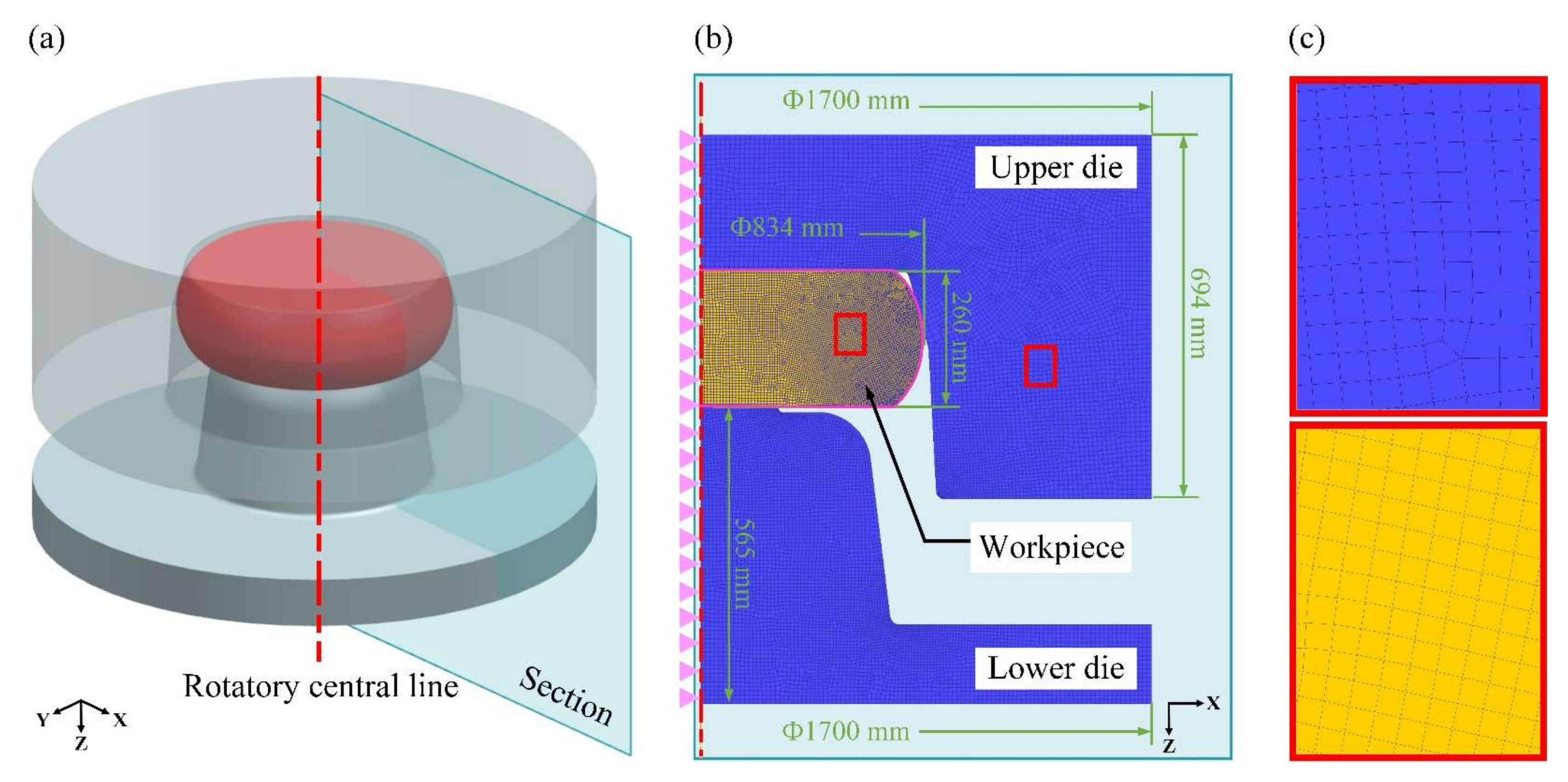

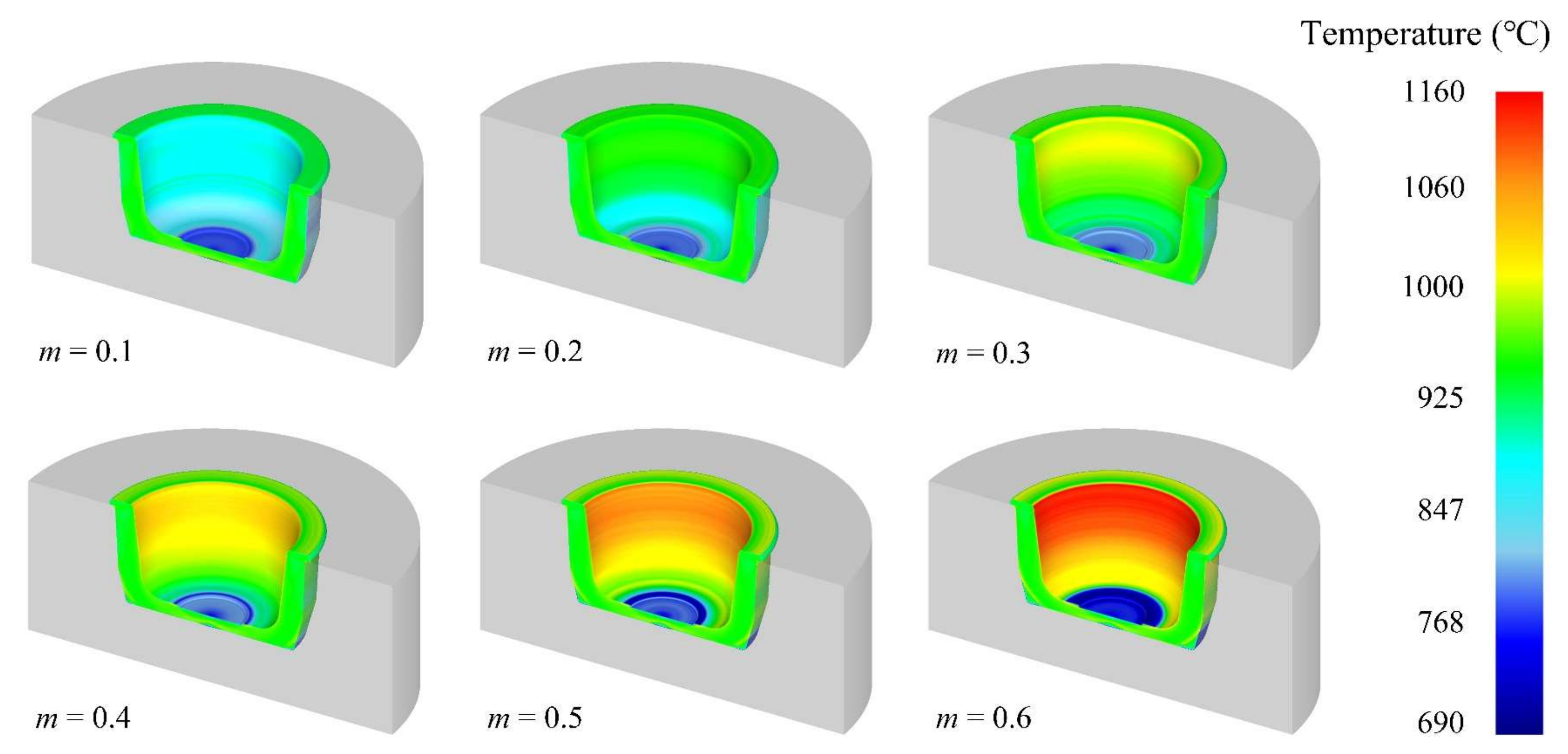
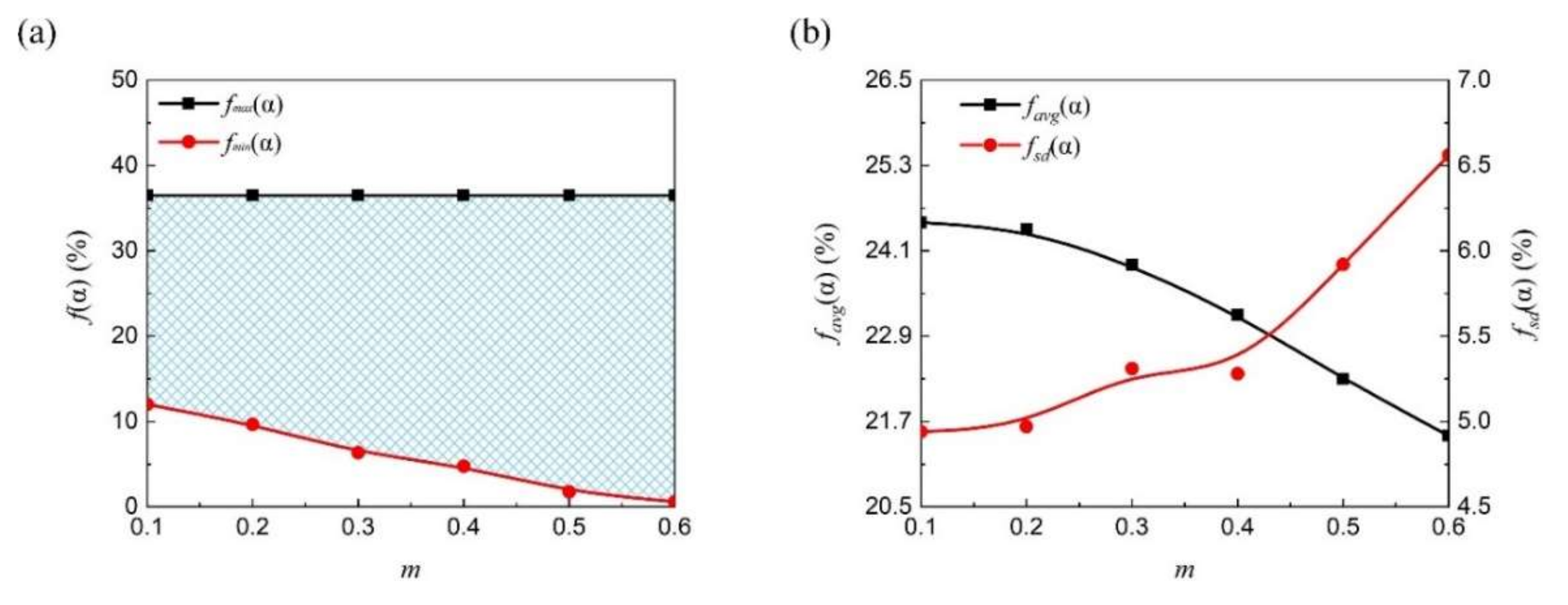


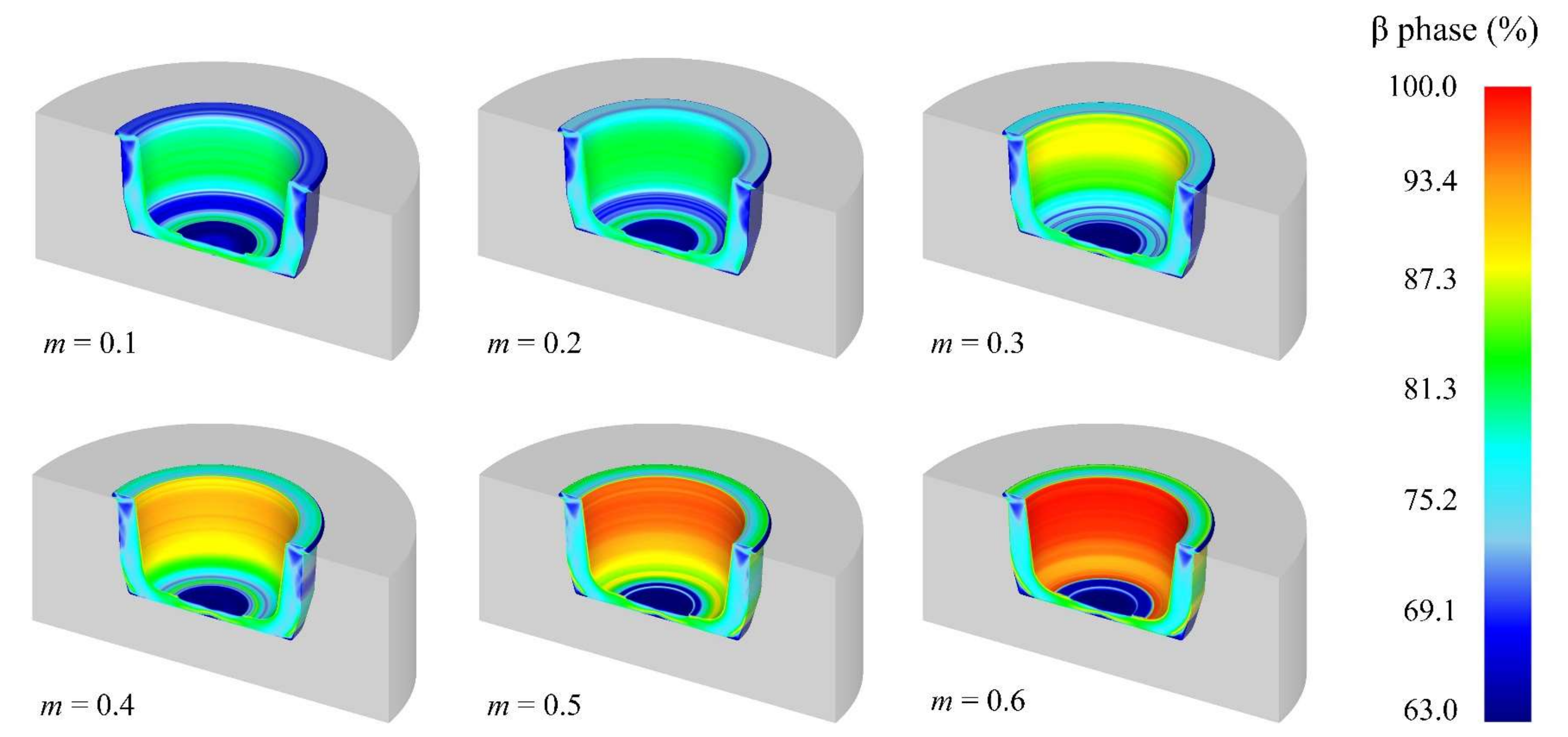

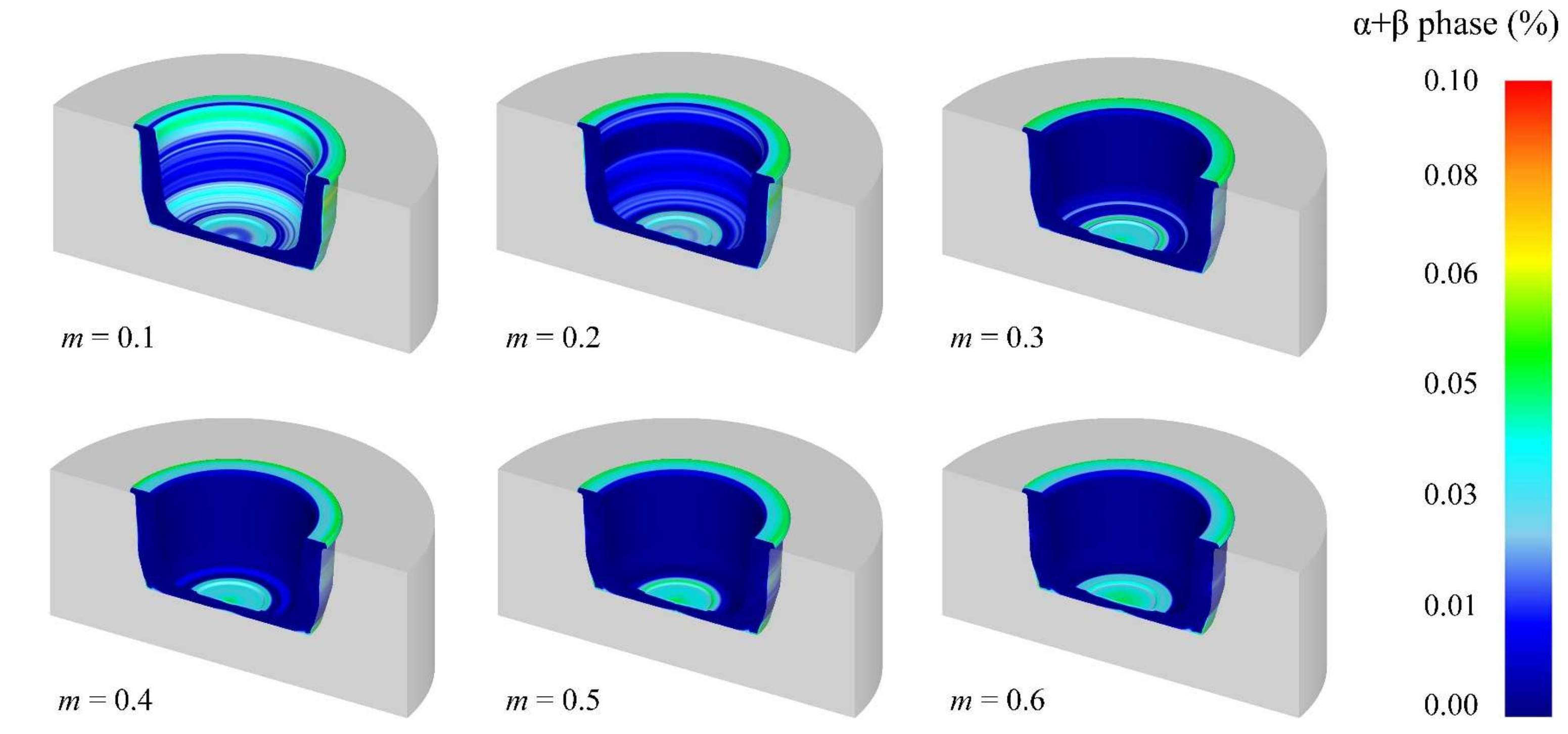

| Parameters | Workpiece | Dies |
|---|---|---|
| Material | Ti-6Al-4V | AISI H13 |
| Heat capacity (N/(mm2 °C)) | Equation (1) | [23] |
| Thermal conductivity (N/(s °C)) | Equation (2) | [23] |
| Emissivity | 0.7 [25] | 0.7 [26] |
| Convection coefficient (N/(s mm °C)) | 0.02 [27] | 0.02 [28] |
| Heat transfer coefficient (N/(s mm °C)) | 5 [22] | |
| Initial workpiece temperature (°C) | 930 | |
| Initial die temperature (°C) | 250 | |
| Environment temperature (°C) | 20 | |
| Forging stroke (mm) | 210 | |
| Forging velocity (mm/s) | 300 | |
| Friction factor | 0.1/0.2/0.3/0.4/0.5/0.6 | |
| Parameters | Mean Values (mm) | |||
|---|---|---|---|---|
| h | d | H | D | |
| Experimental results | 415.5 | 284.6 | 453.7 | 905.6 |
| Simulated results | 414.3 | 283.2 | 455.1 | 907.9 |
| Errors | 0.29% | 0.53% | 0.22% | 0.24% |
Publisher’s Note: MDPI stays neutral with regard to jurisdictional claims in published maps and institutional affiliations. |
© 2021 by the authors. Licensee MDPI, Basel, Switzerland. This article is an open access article distributed under the terms and conditions of the Creative Commons Attribution (CC BY) license (https://creativecommons.org/licenses/by/4.0/).
Share and Cite
Luo, S.; Jiang, Y.; Yan, K.; Zou, G.; Zhang, P.; Yu, F. Numerical Analysis of Friction Effects on Temperature and Phases within Forged Ti-6Al-4V Alloy Aeroengine Drum. Metals 2021, 11, 1649. https://doi.org/10.3390/met11101649
Luo S, Jiang Y, Yan K, Zou G, Zhang P, Yu F. Numerical Analysis of Friction Effects on Temperature and Phases within Forged Ti-6Al-4V Alloy Aeroengine Drum. Metals. 2021; 11(10):1649. https://doi.org/10.3390/met11101649
Chicago/Turabian StyleLuo, Shiyuan, Yongxin Jiang, Kai Yan, Guangming Zou, Po Zhang, and Fengping Yu. 2021. "Numerical Analysis of Friction Effects on Temperature and Phases within Forged Ti-6Al-4V Alloy Aeroengine Drum" Metals 11, no. 10: 1649. https://doi.org/10.3390/met11101649
APA StyleLuo, S., Jiang, Y., Yan, K., Zou, G., Zhang, P., & Yu, F. (2021). Numerical Analysis of Friction Effects on Temperature and Phases within Forged Ti-6Al-4V Alloy Aeroengine Drum. Metals, 11(10), 1649. https://doi.org/10.3390/met11101649






